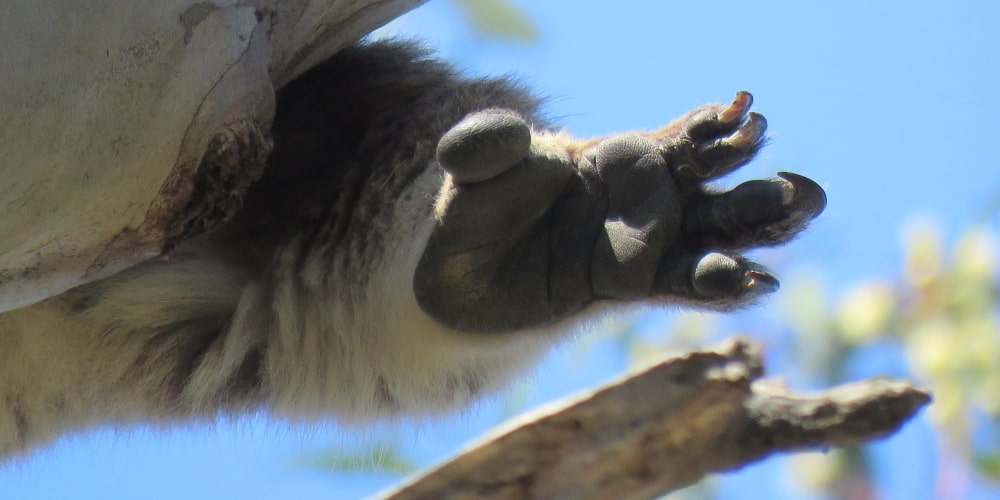Koalas climb trees every day. But that doesn’t mean it’s easy for them.
Pat is an old female koala – she’s 15 years old, which would be equivalent to about 85 or 90 years for a human. She lives in the wild in the You Yangs, near Melbourne, and every day she has to climb up and down a tree at least once.
Not many human 90 year-olds could climb a tree at all, let alone a tough one like this.
Some trees are harder to climb than others. Very big trees, with a wide girth, are difficult because the koala’s arms can’t encircle the tree. It’s just straight up, vertical, using strength and skill.
But big trees have their benefits, and on this day Pat decided that being up this tree was worth it.
With great age comes experience and knowledge. Pat is very smart, and knows this tree well. She doesn’t tackle it head on the hard way, she has a sneaky trick.
Pat uses a ‘ladder’: a smaller tree that leans against the big tree. Ladder trees are easier to climb than big trees. In this case, her ladder is another Ironbark, the same species as the big tree, growing beside it. Watch:
..
She climbs all the way to the top of the little ladder tree, and looks across at her target. She looks up and around, planning her strategy.
Koala Pat wants to get as high up as she can on ladder trees, to limit the tough climb on the big Ironbark.
She finds a thin branch leaning onto the big tree, and takes it.
Once on the big Ironbark her koala climbing style changes. Before, on the ladder tree, she was barely trying, now she is working very hard.

..
Ironbarks have rough bark, which should make climbing easier than smooth barked trees. But where smooth bark is slippery but soft, Ironbarks are hard. Koalas sharp, strong claws can bite into smooth bark to provide traction. But this doesn’t work on an Ironbark.
Koala Pat is mostly using the grip and strength of her large hands and feet. The palms/soles are covered in granulated tough skin that grips well. This climb is very similar to the way a human rock-climber ascends.

..
Watch how carefully she searches for and checks her holds before proceeding. She is 15 metres above ground, and at her advanced age a fall could be fatal.
Higher up, she encounters the real challenge: a large branch leaning out. Her climb is no longer just vertical, it is inverted.
Her body is working against gravity now. That’s not unusual for a koala – they often hang upside-down with no problems….on smooth-barked trees, when they have claws hooked in. But inverted on an Ironbark is hard – only her strength is saving her now.
The powerful muscles of her back, shoulders and arms are keeping her alive. Koalas have enormous upper-body strength. At a gym, they’d be the ones doing the chin-ups with one hand.

..
Koala Pat progressses slowly, but surely. Her foot slips a few times, but she always has three solid points of contact. Her body is glued to the tree, keeping her centre of gravity very close to the surface.
At last she reaches the top of the big branch, and starts to move freely again.
Watching wild koalas, and knowing their age and history, gives us insight into the challenges of their lives. Being a wild koala is hard work. But she is free to make these choices.
Even at advanced age, Koala Pat decided to climb this tree – not just once, but twice (she would have had to come back down again later). She had her reasons for taking on this challenge, and we’ll never know what they were.

..
This shows why it is critical to maintain populations of animals in the wild. We will never know everything about the way a wild species works. We will never understand all of the decisions they make, no matter how much we study. Only in the wild are they living to their full potential.
We need wild animals, living in the wild. They perform ecosystem services that contribute to the water, the air, our food, our very existence. The services they perform are intricate and hard to decipher, but if we lose even a single species from this earth, we weaken the health of our planet.
Echidna Walkabout donates over $50,000 each year to the Koala Clancy Foundation, a charity planting trees for koalas. We also volunteer our time to the charity – co-owner Janine has spent the whole of April organising Wild Koala Day.
Help us help koalas stay wild. Share this post, share a pic you have taken of a koala living in a forest and tag #wildkoaladay. On Monday, call a politician, and demand action on climate change to protect koalas. Check out the website wildkoaladay.com.au for more ways you can help koalas from home.

